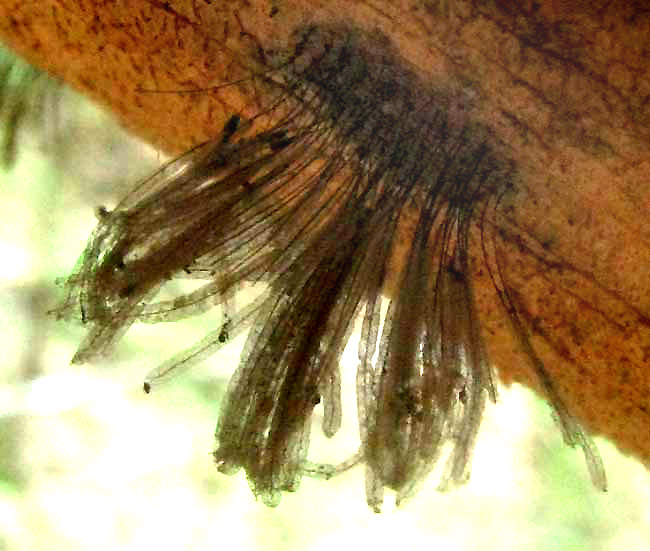Excerpts from Jim Conrad's
Naturalist Newsletter

from the June 17, 2012 Newsletter issued from the woods of the Loess Hill Region a few miles east of Natchez, Mississippi, USA
STEMONITIS SLIME MOLD
In the bottom of a deep, narrow ravine cut into the area's loess mantel I ducked beneath a dead, barkless, overhanging tree trunk. On the dry, shaded bottom of the trunk sprouted a black tuft of wispy items about ¾-inch tall (2cm), as seen above.
I'd seen pictures of such things while studying the slime molds we ran into down in the Yucatan, so a little Internet search quickly yielded the basic information about these tufts, which turned out to be the fruiting bodies, or sporangia, of a slime mold in the genus STEMONITIS. Many species of Stemonitis are recognized but they can be distinguished with certainty only with microscopic examination. Sometimes members of the genus Stemonitis are referred to as Chocolate Tube Slime, Tree Hair, and Pipe Cleaner Slime.
Already we've seen that slime molds, which are not fungi but rather their own kind of thing, experience an amazing life cycle. A spore germinates to form a wandering amoeba-like creature eating mostly bacteria, and which under certain conditions can develop a cilia tail and move about like a tadpole, or develop lobes called pseudopodia, with which it moves like a slug. As food becomes scarce these different creatures can merge into a much larger creature composed of flowing protoplasm with no cell walls, called a plasmodium. The plasmodium wanders about like a giant amoeba ingesting bacteria, spores of fungi and plants, protozoa, and particles of nonliving organic matter. At some point the plasmodium dries up and produces the clustered masses of stalked spore-producing fruiting bodies, or sporangia, shown in the photograph.
The sporangia in the photographs have already been emptied of their spores so you can see right through them.
Stemonitis slime molds are found worldwide except in the Polar Regions.